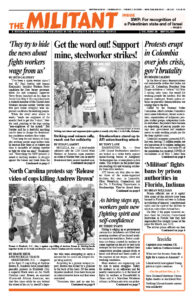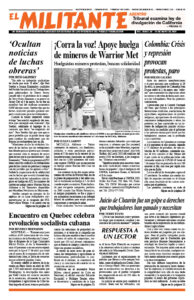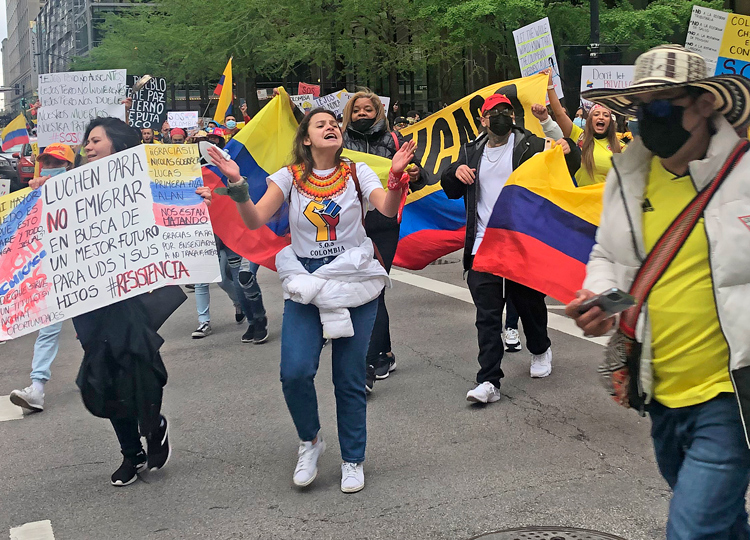In the face of mass demonstrations and nationwide strikes that broke out April 28, Colombian President Iván Duque withdrew a “reform” bill May 2 raising sales taxes that would hit working people the hardest. But the protests continued. Brutal police attacks on peaceful demonstrations are adding fuel to the fire.
Called by the National Strike Committee, which includes Colombia’s main union federations, farmer associations, organizations of indigenous peoples, student groups, independent truckers and others, the protests have become an outpouring of pent-up popular outrage over government and employer moves to make working people pay for the deep capitalist crisis.
Colombia’s economy contracted 6.8% last year, leaving 7.5 million people, out of a population of 50 million, eating less than three meals a day. Just under 8% of the population has received COVID-19 vaccinations as of May 7, lower than hard-hit Brazil. There are nearly 500 deaths a day on average, a higher per capita rate than in India.
The official unemployment rate is more than 17%, and over 20% in some cities. It’s estimated that half a million businesses closed in the last year as a result of government lockdowns.
Protests swelled across the country after police brutally attacked demonstrators. At least 25 people have been killed since the protests started, hundreds injured, more than 800 arrested and dozens are “missing.” The government deployed army tanks, firing live rounds, in an attempt to quell the protests.
Protesters have set up roadblocks on major highways, cutting off supplies into Bogotá, Cali and other cities. The government threatened to seize the trucks and vehicles used to build the blockades. These “termination of ownership” measures were introduced by the Colombian rulers earlier, allegedly to combat “terrorism” and drug trafficking.
While most of the protests have been peaceful, government propaganda has focused on participants who burned down police kiosks and public buildings, and some looting that took place. Trade union leaders and other members of the National Strike Committee condemned the acts of vandalism.
In Cali, on the first day of the protests, demonstrators recovered stolen items and marched to the stores to return them. They chanted, “We the good people are the majority,” a strong response to the government’s violence-baiting of them.
Toilers’ response to attacks
“The companies are using the pandemic as an excuse to fire workers, including some who are ill. Despite the government giving them subsidies to not lay off people, the companies lay workers off anyway and keep the money,” Daniel Morón, from the Sintracarbón mineworkers union, told the Militant by phone from Riohacha. Starting May 6, some 220 fired mineworkers blocked roads leading to the El Cerrejón mine, demanding their jobs back, he said.
“The government favors the agricultural monopolies and highly subsidized multinationals from the U.S. and the European Union. We can’t compete with them,” Oscar Gutiérrez, of Dignidad Agropecuaria Colombiana, a federation of small farmer groups, told the Militant from Manizales. “Small farmers don’t get loans, and costs of fertilizer, seeds and pesticides keep going up. Many rice, corn, and milk farmers have gone bankrupt.
“We had a big mobilization planned last year, but then the pandemic hit,” said Gutiérrez. “The situation has only gotten worse.”
A motorcade of trucks, and delivery and passenger van operators joined the protests May 1 in Bogotá. They face similar pressures with the high cost of fuel, insurance, tolls, and other costs. “It can’t be that we, who don’t even make enough to cover operating expenses, have to carry on our backs the country’s budget,” freight truck driver Andrés Betancourt told El Tiempo.
Duque insisted the tax increases were necessary to continue an emergency pandemic dole scheme rolled out in April 2020 that provides monthly payments of $43 to about 3 million people.
The measure, demagogically dubbed the “Sustainable Solidarity Law,” increased the sales tax from 16% to 19% on electricity, water and gas consumption. To make it appear equitable, it also would have raised taxes on those earning above $663 a month, in a country where the minimum wage is $260.
The sales tax hike was like “rubbing salt on the wound,” say many demonstrators. Now the government has raised a health “reform” law that many workers believe would attack their access to medical care.
An impending crisis
Latin America registered the sharpest economic contraction in the world in 2020. Tens of millions have been left without jobs, facing conditions similar to those in Colombia.
Governments in the semicolonial world have borrowed heavily from foreign and domestic capitalist lenders to try to keep their economies afloat. Many of these countries, which depend on raw material exports, tourism or remittances, were already deeply indebted before the pandemic slowdown. The International Monetary Fund and World Bank have suspended payments or restructured debts for some of the countries.
The protests in Colombia portend unrest across Latin America as the capitalist rulers move to impose cuts in health care, education and other social spending as the debts loom.
On May 6 the Colombian government ordered the expulsion of Omar Rafael García, first secretary of the Cuban Embassy in Bogotá, claiming that he was “carrying out activities in the country that are incompatible” with diplomatic relations.
“This unjustified action is an attempt to divert the attention of the international community and Colombian society from the violent repression by military and police forces against the protesters,” the Cuban Ministry of Foreign Affairs said in a statement.
The real fear of the Colombian rulers is not that Cuban diplomats will intervene in the country’s internal affairs — a charge the Cuban government categorically denies. It’s the living example of the Cuban Revolution, which shows it’s possible to make a revolution to replace capitalist rule with a government of workers and farmers.
Seth Galinsky contributed to this article.


